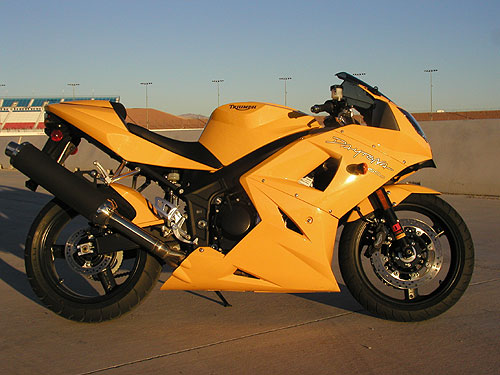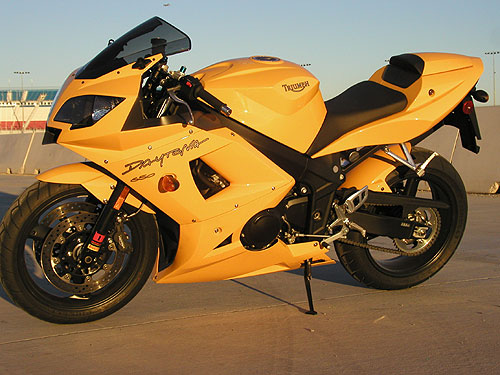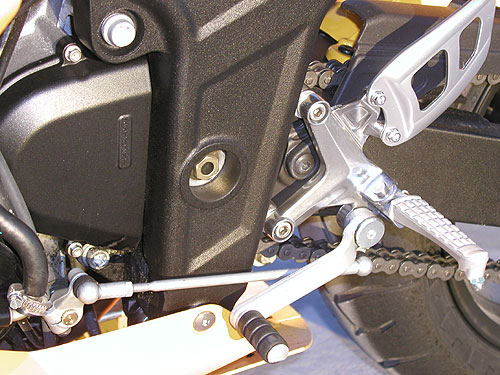2005 Triumph Daytona 650
Las Vegas, NV
November 15, 2004
I was on a high speed burn across the desert when my cell phone rang. Editor Ulrich calling. After some ritualized castigation about deadlines, photo requirements, spec charts and how, yet again, I was totally screwing him with my slothful, unproductive work ethic, he asked about the bike I had just spend the day abusing in the wasteland that is Nevada. A man staring down the insatiable beast that is the deadline of a national magazine does not have time to mince words.
Still a looker.
“So” my editor said unmincingly, “would you buy one over a Kawasaki 636?”
Being a product of my hometown of Washington D.C. my mind reeled at the challenge of answering such a direct question. Quickly searching through my repertoire of my usual DC answers I discarded ‘I do not recall, Senator’ and ‘You’ve got nothing on me; that could have been anyone’s ass in those pictures.’
“It depends,” I answered decisively and hung up.
Performance is a green-eyed monster that doth mock the meat on which it feeds. In a racetrack environment pure performance is the criteria and it is a simple formula to calculate: “this bike turns faster lap times than that bike so this one is better”. Street bikes, however, have a much more complicated algorithm because the performance is part of something that is much more difficult to quantify: style. Much of what the Triumph is lacking in stylish forks or brakes is recovered through brand exclusivity.
Nice frame.
The Triumph Daytona 650 is functionally a Triumph Daytona (the 600cc version see Roadracing World: June 2003) with new rods and a crankshaft with a 3.2mm increased stroke that increases displacement 47cc from 599cc to 646cc.
The power that a four stroke motor can potentially deliver is governed by many things but, to a large extent, it comes down to a balance of piston bore versus stroke. For a given displacement a larger bore (with a shorter stroke) allows for a high redline and larger valves. Taking advantage of the higher redlines means cams with longer duration with lots of overlap and that typically results in engines with high revving peaky horsepower such as are found in middleweight supersport bikes.
It is pretty tricky to increase the bore in a production engine as it involves new castings for the cylinders and head. Increasing the displacement by stroking the motor, however, is a relatively straightforward proposition involving, for instance, making a crankshaft with 3.2mm longer stroke and conrods that are 1.6mm shorter. This change boost displacement by the aforementioned 47cc and, without changes to the piston crown or combustion chamber, it increases the compression ratio from 12.75:1 to 12:85:1. However, because the valve area has not been changed the engine can’t ultimately flow much more air than it did as a 600 and so, although the engine displacement has increased 7.85%, the peak horsepower has only increased 1.79%.
It is very rare on a racetrack, and even rarer on the street, that one ever gets to actually use the peak horsepower. Most of the time one is riding on the track one is accelerating to the peak horsepower and few people ride around on the street with their engines screaming at 12,000rpm. The key here is mid-range torque. That is the kind of power that lets you pass other 600s out of slow turns, pull power lifts away from stoplights and, dare I say it, ride with a passenger. Although the 650’s stroked motor delivers scant more peak horsepower it provides a nice fleshed out powerband of torque that is immediately apparent to the rider.
Remember when 14,000 was a high redline?
The Daytona 650 pulls first gear powerlifts like a mid-90 GSX-R 750 and allows a rider to recover from a blown corner entrance with aplomb. Say one were to miss an apex and find oneself drifting wider and wider into a turn, scrubbing speed and letting the engine RPMs drop out of the sweet zone. On a peaky engine one would have to downshift (if that could be accomplished without upsetting the chassis mid-turn which, more often than not, is not really an option) or roll the throttle back on and suffer through the bog until the engine got back into its powerband. On the 650 you just point and shoot. It doesn’t really matter where you are in the rev-range since the ample bottom end power will allow you to accelerate at anytime.
It is good thing that the motor is forgiving since the chassis in which it is mounted, a little dated when first released two years ago, is definitely showing its age now. The bike has a more upright seating position than most sportbikes that leads to some frustration on the track and much enhanced comfort on the street. Since this bike is targeted to a street audience the spacious accommodations are appropriate. Think CBR F3 as a reference point.
Matte black muffler was fitted because, apparently, the old one was hard to clean (guys, matte black is really hard to keep clean…ask me how I know.)
The F3 analogy works well for the front end as well. Whereas many of the middleweight bikes feature USD forks or large diameter (45mm) telescopic forks the Daytona is fitted with 43mm conventional Kayaba; a fork that was not exactly cutting edge even five years ago. Bolted to the forks are some Triumph badged four piston calipers clamping some alarmingly thin (3.5mm!!!) front brake rotors. Past experience would suggest that, fitted with some nice grippy sintered brake pads, those thin rotors would warp in an afternoon at the turn one brake markers at Summit Point or VIR. As delivered, and despite braided steel lines as standard fitment, the brakes where a little underwhelming. Some of this might be due to conservative brake pad fitment common to many stock motorcycles.
The forks are set a conservative 24.6 degrees of rake (which is ponderous by modern race standards) coupled with low trail numbers of 89.1 to deliver decent steering. With a disclaimer about “I am not a geometry expert but I faked being one in a national motorcycle magazine” I will put forth my own experience as such. Low rake numbers (like, say, 22.5) make for fast steering motorcycles that are twitchy and, perhaps, even prone to a few head shakes now and again. Higher numbers (such as 24.6) create slow steering motorcycles with an emphasis on stability. Low trail numbers (say, below 90mm) give faster steering but at the expense of high speed mid-corner feel.
State of the art, in 1997.
High trail numbers slow steering but give a wider margin at the edge in fast turns. With its high rake and low trail the Daytona offers great nimble steering and rock solid stability to a 90% pace. Push past that level and the handling reverse, the bike starts to run wide out of turns and the front end starts to feel tentative in the fast sweepers. Again, since the bike is not designed to be a front running race bike the bias on stability and predictable handling at street or track day pace makes sense but expert riders may find themselves asking the bike to do things that it is reluctant to do. A common trick to sharpen up the handling on a motorcycle is to raise the rear ride height. Unfortunately the Triumph does not have a way to do that in a convenient manner.
The 600 version of the Triumph had a direct shift lever (like most dirt bikes) which is simple and light but does not allow for an easy reversal of the shift pattern or, more importantly in this case, is did not allow for the use of simple machines (levers) to decrease the throw required on the shift lever to make a shift in the transmission. The new Daytona has a GSX-R style linkage that provides tighter shifts and looks like it could be easily reversed for GP pattern shifting.
Riders only have a few points of direct contact with a motorcycle including the handlebars, the seat and the footpegs. I am always baffled by the scant attention that most motorcycle designers pay to the footpegs. In my pedantic opinion footpegs should be toothy and grippy to prevent a boot from ever slipping around in wet conditions and the rear set and heel guards should be smooth and broad to prevent any sort of interference with boots when the rider is contorting the foot into all possible riding positions. Many manufactures get these simple criteria incorrect and Triumph is no exception. The heal guards extend out over the footpegs with a gap between the peg and the guards. Boot heels and/or plastic external protection on the boots get caught up in that gap and require rider attention to either free the foot or prevent entanglement. A small annoyance but it is only through an open exchange of constructive criticism can we ever expect improvement.
Note the heel grabbing gap between the guard and the peg.
The engine design of the Daytona is a very traditional single split crankcase design that makes for a comparatively long power plant by today’s standards. New crankcases are expensive and time consuming to develop hence the stopgap measure with the stroker engine.
Thirty-five years ago English industry was torn with labor disputes and capital problems. Adding to their woes, the Japanese showed up with some oil tight, decently manufactured, powerful machines that basically mopped up the floor with the offerings from Triumph, Norton et al. The English had put off capital investment in newer designs and, instead, pushed the limits of older designs.
Pushing the limits of older designs lead to some pretty spectacular failures. Transmissions originally designed for 25 bhp were asked to transmit 50 with the predictable catastrophic results. Crankcases designed for low compression 500cc engines were fitted with high compression 750cc top ends that would physically tear the cylinder studs out of the castings. Customers dried up and ultimately Norton and Triumph were forced to basically close up shop.
Fast forward to 2004. Triumph is the only manufacturer that is bold enough to take on the Japanese in the most hotly contested and technologically sophisticated segment of the motorcycle industry.
Bravo.
They released a product in 2000 (the original TT600) that is lagging behind the other bikes by a year or two but, in the broad sense of things, that is okay.
Pushed by popularity the middleweight market became even more competitive and the Japanese quickly leap frog each other to specify high-grade fitment of suspension, brakes and motors into their middleweight machines. Suddenly the Triumph is not a couple years behind, it is more like five or six years behind. In response to that pressure they respond with a quick fix (long stroke crank) instead of the re-design and re-tooling that would be required to catch up to or (dare we dream) pass the Japanese.
This strategy may work to keep the Daytona selling for a few more years (particularly with its price drop) but there was a worrisome phenomenon at the press launch. I killed two out of the six bikes present.
Both times I was exiting a slow turn when I felt the bike lose power. Entering the next turn off the throttle I could feel excessive drag in the drive train. Steady throttle at 6,000 rpm would elicit a steady knocking in the engine consistent with rod bearing failure. We did not autopsy the engines at the press launch to determine what exactly had failed but assuming the proper oil level had been maintained we may have witnessed the return of the problems inherent with stretching the limits on an older design.
No one will choose the Triumph as the basis for a race platform so the Daytona is aimed at street riders who might want to hit the occasional track day. Putting myself into that mindset I rephrased Ulrich’s initial question to “Would you rather sport the iconoclast image by riding around town and humiliating track day R1 riders on a Triumph or be another squid on a ZX-6?”
To that question I would say “Yes”.







